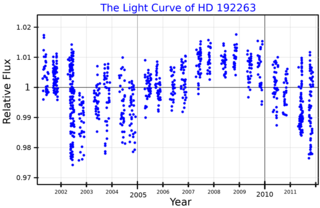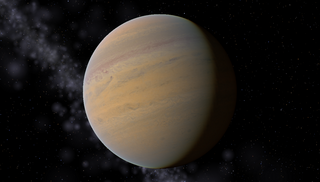Related Research Articles

HD 209458 is an 8th-magnitude star in the constellation Pegasus. It is a G0V star, and is thus very similar to the Sun. Because it is located at a distance of 157 light-years, it is not visible to the unaided eye. With good binoculars or a small telescope it should be easily detectable.
HD 37124 is a star in the equatorial constellation of Taurus, positioned about a half degree to the SSW of the bright star Zeta Tauri. The apparent visual magnitude of this star is 7.68, which is too dim to be visible to the naked eye. It is located at a distance of 103 light years from the Sun based on parallax, but is drifting closer with a radial velocity of −23 km/s. Three extrasolar planets have been found to orbit the star.
HD 82943 is a yellow dwarf star approximately 89 light-years away in the constellation of Hydra. Two extrasolar planets have been confirmed to be orbiting it, and it is thought that the system had more giant planets that were "swallowed" by the parent star. HD 82943 is estimated at 1.15 times the mass of the Sun.
HD 168443 is an ordinary yellow-hued star in the Serpens Cauda segment of the equatorial constellation of Serpens. It is known to have two substellar companions. With an apparent visual magnitude of 6.92, the star lies just below the nominal lower brightness limit of visibility to the normal human eye. This system is located at a distance of 127 light years from the Sun based on parallax, but is drifting closer with a radial velocity of −48.7 km/s.

HD 192263 is an 8th magnitude star about 64 light years away in the constellation of Aquila. The spectral type of the star is K2V, meaning that it is an orange dwarf, a type of star somewhat cooler and less luminous than the Sun. It is not visible to the unaided eye, but with good binoculars or small telescope it should be easy to spot.
HD 177830 is a 7th magnitude binary star system located approximately 205 light-years away in the constellation of Lyra. The primary star is slightly more massive than the Sun, but cooler being a type K star. Therefore, it is a subgiant clearly more evolved than the Sun. In visual light it is four times brighter than the Sun, but because of its distance, about 205 light years, it is not visible to the unaided eye. With binoculars it should be easily visible.
109 Piscium is a yellow hued G-type main-sequence star located about 108 light-years away in the zodiac constellation of Pisces. It is near the lower limit of visibility to the naked eye with an apparent visual magnitude of 6.27. The star is moving closer to the Earth with a heliocentric radial velocity of −45.5 km/s. It has one known exoplanet.

23 Librae b, also known as HD 134987 b, is an extrasolar Jovian planet discovered in November 1999 orbiting the star 23 Librae. It orbits in its star's habitable zone.

79 Ceti b is an extrasolar planet orbiting 79 Ceti every 75 days. Discovered along with HD 46375 b on March 29, 2000, it was the joint first known extrasolar planet to have minimum mass less than the mass of Saturn.

109 Piscium b is a long-period extrasolar planet discovered in orbit around 109 Piscium. It is about 5.74 times the mass of Jupiter and is likely to be a gas giant. As is common for long-period planets discovered around other stars, it has an orbital eccentricity greater than that of Jupiter.
HD 222582 is a multiple star system in the equatorial constellation of Aquarius. It is invisible to the naked eye with an apparent visual magnitude of 7.7, but can be viewed with binoculars or a small telescope. The system is located at a distance of 138 light years from the Sun based on parallax, and it is drifting further away with a radial velocity of +12 km/s. It is located close enough to the ecliptic that it is subject to lunar occultations.

Epsilon Eridani b, also known as AEgir [sic], is an exoplanet approximately 10.5 light-years away orbiting the star Epsilon Eridani, in the constellation of Eridanus. The planet was discovered in 2000, and as of 2023 remains the only confirmed planet in its planetary system. It orbits at around 3.5 AU with a period of around 7.6 years, and has a mass around 0.6 times that of Jupiter. As of 2023, both the Extrasolar Planets Encyclopaedia and the NASA Exoplanet Archive list the planet as 'confirmed'.
HD 37124 b is an extrasolar planet approximately 103 light-years away in the constellation of Taurus. The planet was discovered in 1999 orbiting the star HD 37124. Based on its mass, it is most likely that this planet is a Jovian planet.
HD 183263 b is an extrasolar planet orbiting the star HD 183263. This planet has a minimum mass of 3.6 times more than Jupiter and takes 625 days to orbit the star. The planet was discovered on January 25, 2005 using multiple Doppler measurements of five nearby FGK main-sequence stars and subgiants obtained during the past 4–6 years at the Keck Observatory in Mauna Kea, Hawaii. These stars, namely, HD 183263, HD 117207, HD 188015, HD 45350, and HD 99492, all exhibit coherent variations in their Doppler shifts consistent with a planet in Keplerian motion, and the results were published in a paper by Geoffrey Marcy et al. Photometric observations were acquired for four of the five host stars with an automatic telescope at Fairborn Observatory. The lack of brightness variations in phase with the radial velocities supports planetary-reflex motion as the cause of the velocity variations. An additional planet in the system was discovered later.
HD 30177 b is an extrasolar planet located approximately 181.6 light-years away in the constellation of Dorado, orbiting the star HD 30177.
HD 40979 b is an extrasolar planet orbiting the star HD 40979, was detected from the Lick and Keck observatories and photometric observations at Fairborn Observatory reveal low-amplitude brightness variations in HD 40979. It is thought to be a large gas giant planet. It was discovered in 2002 by Debra Fischer.
HD 46375 b is an extrasolar planet located approximately 109 light-years away in the constellation of Monoceros, orbiting the star HD 46375. With 79 Ceti b on March 29, 2000, it was joint first known extrasolar planet less massive than Saturn orbiting a normal star. The planet is a "hot Jupiter", a type of planet that orbits very close to its parent star. In this case the orbital distance is only a tenth that of the planet Mercury. No transit of the planet has been detected, so its inclination must be less than 83°. Because the inclination is unknown, the true mass of the planet is not known.
HD 49674 b, formally named Eburonia, is an extrasolar planet located approximately 134 light-years away in the constellation of Auriga, orbiting the star HD 49674. This planet was discovered orbiting the star in 2002. The planet is a gas giant and orbits extremely close to its star, which takes only 4.95 days to revolve.
HD 192263 b, also named Beirut, is a gas giant planet with a mass about three quarters that of Jupiter mass. It orbits the star in a circular orbit completing one revolution in 24 days or so. It was discovered in 2000 by the Geneva Extrasolar Planet Search team. The planet was independently detected by the California and Carnegie Planet Search team.

An exoplanet is a planet located outside the Solar System. The first evidence of an exoplanet was noted as early as 1917, but was not recognized as such until 2016; no planet discovery has yet come from that evidence. What turned out to be the first detection of an exoplanet was published among a list of possible candidates in 1988, though not confirmed until 2003. The first confirmed detection came in 1992, with the discovery of terrestrial-mass planets orbiting the pulsar PSR B1257+12. The first confirmation of an exoplanet orbiting a main-sequence star was made in 1995, when a giant planet was found in a four-day orbit around the nearby star 51 Pegasi. Some exoplanets have been imaged directly by telescopes, but the vast majority have been detected through indirect methods, such as the transit method and the radial-velocity method. As of 1 December 2023, there are 5,550 confirmed exoplanets in 4,089 planetary systems, with 887 systems having more than one planet. This is a list of the most notable discoveries.
References
- ↑ "Astronomers discover six new planets orbiting nearby stars" (Press release). Kamuela, Hawaii: W. M. Keck Observatory. November 1, 1999. Retrieved December 19, 2017.
- 1 2 Vogt, Steven S.; et al. (2000). "Six New Planets from the Keck Precision Velocity Survey". The Astrophysical Journal. 536 (2): 902–914. arXiv: astro-ph/9911506 . Bibcode:2000ApJ...536..902V. doi:10.1086/308981. S2CID 119375519.
- ↑ NASA.gov
- ↑ NASA.gov
- Gimenez; A. (2000). "uvby Photometry of stars with planets". Astronomy and Astrophysics. 356: 213. Bibcode:2000A&A...356..213G. Archived from the original on 2011-09-28. Retrieved 2011-08-16.
- Han; Black, David C.; Gatewood, George (2001). "Preliminary astrometric masses for proposed exrasolar planetary companions". The Astrophysical Journal Letters . 548 (1): L57–L60. Bibcode:2001ApJ...548L..57H. doi:10.1086/318927.